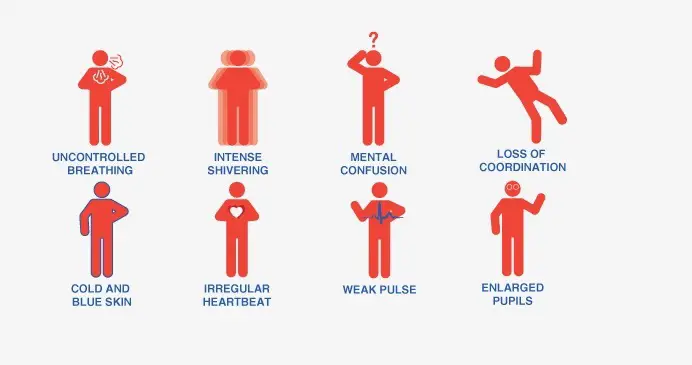Hypothermia occurs when your body reaches a dangerously low temperature (below 95 F, or 35 C) because it is unable to produce heat at the same rate it loses it. This is a medical emergency that, if untreated, can lead to death.
How to detect Hypothermia
The most obvious symptom of hypothermia is shivering – this is the body’s automatic attempt to warm itself. However, the shivering will stop as hypothermia worsens.
Other signs of mild hypothermia include:
- dizziness,
- nausea,
- fatigue,
- trouble speaking and coordinating,
- slight confusion,
- hunger,
- increased heart rate and breathing.
If the body temperature continues to drop, advancing into moderate to severe hypothermia, further signs become noticeable; these include: mumbling, accentuated drowsiness, clumsiness, confusion coupled with a lack of self-awareness and even risk-taking behavior, a weak pulse, and shallow breathing.

In infants, hypothermia manifests itself through very low energy, a weak cry, and skin that is cold and bright red.
How to ease symptoms of Hypothermia
The most important thing is to warm the body. At the first signs of hypothermia, call your local emergency number. Until help arrives, very slowly, so as not to cause them irregular heartbeats, try to take the person inside, remove their wet cloths, and cover them in several blankets.
Prevention
Since hypothermia occurs most often in cold weather, it is important to always stay warm. MayoClinic suggests you can do this if you remember the acronym COLD (cover, overexertion, layers, dry):
Cover up your head, face, neck, and hands with hats, scarves and mittens (rather than gloves).
Overexertion must be avoided because sweating a lot in the cold can lead to accelerated body heat loss.
Layers of loose, lightweight clothing will keep you warm. Wear wool, silk or polypropylene (instead of cotton) close to the body, and tightly woven materials that keep away water and wind as the outer layer.
Dry – keep your hands and feet dry, and change your clothes as soon as they get wet.
If you must drive in winter, make sure you have emergency supplies in your car, and that someone knows your destination place and time, should you get stranded. Until help arrives, run the engine 10 minutes per hour, and make sure there is nothing covering the exhaust pipe.
If you accidentally fall in cold water, try to climb as often as possible onto some floating object. Don’t swim unless you’re close to shore. Reduce heat loss by zipping up and buttoning your clothes, and holding your knees to your chest, your arms to your sides and your head back; huddle with others, if possible.









































